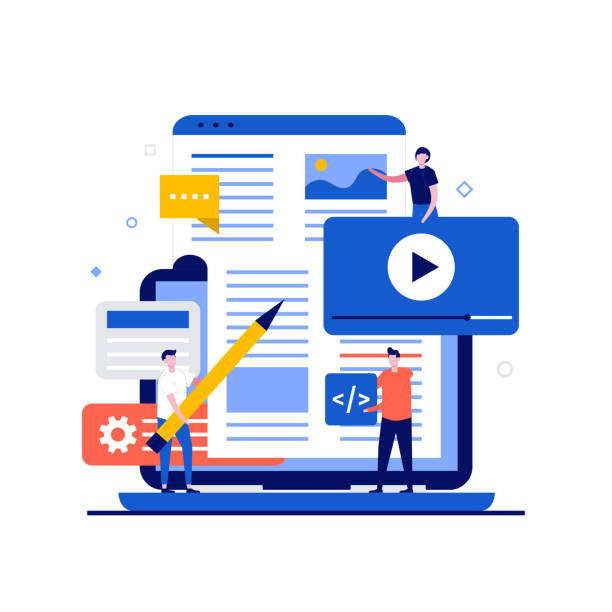Introduction and the Importance of Fast Website Design in the Digital Age

In today’s fast-paced world, where information is incredibly accessible, users’ expectations for website loading speed have significantly increased.
Fast website design is no longer a competitive advantage; it’s an undeniable necessity.
Every second of loading delay can lead to the loss of potential customers, a decrease in conversion rates, and a negative user experience.
#WebsiteDesign #Optimization #WebsiteSpeed.
This issue is not limited to e-commerce sites; blogs, news sites, educational platforms, and any other online presence require fast website design for success.
Have you ever wondered why some sites load in a fraction of a second upon clicking, while others keep you waiting?
This clear difference is a direct result of a purposeful approach to optimization and fast website design.
Understanding the importance of this topic is the first step towards an efficient and successful website.
The explanatory content in this section helps you grasp the depth of this need and feel its urgency in today’s competitive landscape.
Increased competition in the online space has doubled the need for high-performance websites.
Sites that lack adequate speed not only frustrate users but also send negative signals to search engines, which can affect their rankings.
From an analytical perspective, the higher the loading speed, the greater the likelihood of user interaction with the site and a reduction in the Bounce Rate.
This is a cause-and-effect chain that ultimately leads to the profitability and success of your online business.
For example, Google’s research has shown that even a 100-millisecond delay in loading can reduce the conversion rate by up to 7%.
Imagine how catastrophic this reduction could be for a high-revenue e-commerce site.
Therefore, investing in fast website design is a smart and strategic decision for any business or individual seeking an effective presence in the digital space.
This includes optimizing server-side code, minimizing HTTP requests, and using advanced caching techniques, all of which will be discussed in detail in future chapters.
Website speed, as one of the main factors in user experience, not only affects visitor satisfaction but also directly impacts Return on Investment (ROI).
Statistics show that users are increasingly avoiding slow websites.
Consequently, designing a high-speed website is of strategic importance and should be a priority in website planning and development.
Are you bothered by losing customers due to your online store’s outdated appearance or slow speed? RasaWeb’s expert team solves these problems with professional e-commerce website design!
✅ Increase customer trust and your brand’s credibility
✅ Blazing fast speed and excellent user experience
Get a free consultation with RasaWeb right now ⚡
Key Factors Affecting Website Speed and Specialized Solutions

To achieve fast website design, understanding the factors influencing it is of paramount importance.
These factors can vary from the smallest coding details to the largest decisions related to hosting infrastructure.
One of the most important factors is the total volume of data that needs to be transferred from the server to the user’s browser.
This includes images, videos, CSS, JavaScript, and HTML files.
The smaller the size of these files, the faster the loading speed will be.
Managing and compressing this content is a fundamental step that requires specialized knowledge.
Another factor is the quality and type of web hosting.
Cheaper shared hosting might have limited resources, leading to reduced website speed during peak traffic.
Using dedicated servers or VPS with sufficient resources can significantly impact the speed of your fast website design.
This is a strategic decision that affects the overall stability and performance of your website.
The number of HTTP requests that the browser must send to the server to fully load a page also plays a crucial role.
The fewer these requests, the higher the loading speed, because each request requires time for sending, processing, and receiving a response.
Consolidating CSS and JavaScript files and using Sprites for small images can help reduce these requests.
These specialized actions help minimize the load on the server and browser.
The complexity of JavaScript and CSS codes can also reduce page rendering speed, causing the user to see the page gradually or with a delay.
Optimizing codes, removing unnecessary codes, and using Minification (minifying) and Deferring (deferring loading) techniques for scripts are specialized measures in this area that help load main content faster.
Content Delivery Networks (CDN) also significantly reduce loading time by storing cached versions of website content on servers closer to users.
This is an educational and specialized solution that helps increase your website’s efficiency and is essential for sites with international traffic.
Additionally, choosing the right Content Management System (CMS) and using optimized templates and plugins also greatly impact the final website speed.
Heavy and unnecessary plugins can easily slow down a site and waste server resources.
Therefore, intelligent selection and removal of unnecessary items are part of the process of achieving fast website design, requiring review and technical knowledge.
An optimized database and efficient queries also play a role in overall site speed; inefficient queries can slow down the server and consequently delay loading.
Image and Media Optimization Techniques for Speed Enhancement

Images and media files usually constitute the largest portion of a web page’s size.
This means that optimizing these elements is a critical step and a very important guide to achieving fast website design, potentially yielding the greatest returns.
The first technique is image compression without a noticeable loss in quality.
New image formats like WebP or AVIF offer higher compression ratios compared to JPEG and PNG and can significantly reduce file size.
Numerous online tools and CMS plugins are available for this purpose, making the task easier for you.
Another technique is setting the correct image dimensions.
An image uploaded with dimensions larger than what is actually needed for the page imposes an extra load on the server and user’s bandwidth, increasing loading time.
Always use appropriate dimensions for web display and save images in the correct size and quality before uploading.
Using Lazy Load (lazy loading) for images and videos means that content is only loaded when the user scrolls to that part of the page and it becomes visible.
This makes the initial page load much faster, as there’s no need to load all visual content at the beginning, consuming fewer resources.
This is a specialized solution that greatly improves user experience and conserves bandwidth.
Also, considering Responsive Image features in HTML using the <picture> tag or srcset to provide different image sizes based on the user’s device screen size is essential.
This is particularly crucial for mobile users who might be using slower internet, and it significantly contributes to fast website design.
The table below shows some of the best image optimization methods and tools to help you choose the right path:
| Optimization Technique | Description | Suggested Tools |
|---|---|---|
| Image Compression | Reduce file size without significant quality loss for faster loading | TinyPNG, ImageOptim, Compressor.io, Imagify |
| Using New Formats | WebP, AVIF for better performance and excellent compression | Squoosh, Convertio, WebP Express |
| Lazy Loading | Load images only when needed (user scrolls) to reduce initial load | CMS plugins (e.g., WP Rocket, Smush), native browser support (loading=”lazy”) |
| Correct Image Dimensions | Use dimensions appropriate for web display to prevent unnecessary loading | Adobe Photoshop, GIMP, Online Resizers, ImageMagick |
Additionally, optimizing videos is also highly important as they can be very large.
Using lightweight players, compressing videos with modern codecs (such as H.264 or H.265), and hosting videos on platforms like YouTube or Vimeo instead of directly on your own server can significantly contribute to fast website design and reduce server load.
This is a smart solution for managing heavy multimedia content.
The Role of Hosting and CDN in Achieving Maximum Website Speed

Web hosting infrastructure and the use of Content Delivery Networks (CDN) are considered main pillars in achieving fast website design.
These two factors form the foundation of your website’s speed, and their correct selection can make a significant difference in performance.
Choosing a reputable hosting service tailored to your website’s needs is the first crucial step.
There are various types of hosting, including shared hosting, VPS (Virtual Private Server), dedicated server, and cloud hosting.
While shared hosting might suffice for small, low-traffic websites, for high-traffic websites or those requiring flawless performance, using a VPS or dedicated server is recommended, as they guarantee more resources and prevent interference with other sites.
WordPress-optimized hosting or hosting for other CMSs can also offer better performance because their settings and resources are optimized for those systems.
A CDN, or Content Delivery Network, is a network of servers located in various geographical points around the world that store cached versions of your website’s static content (such as images, CSS, JavaScript).
When a user visits your website, the CDN delivers the content from the server closest to that user’s geographical location, which significantly reduces loading time and minimizes network latency.
This is an explanatory and specialized solution that helps increase global website speed and improves user experience for visitors worldwide.
Cloudflare, Amazon CloudFront, and Akamai are among the popular CDN providers.
These networks not only increase speed but also help the site withstand cyberattacks (such as DDoS) and traffic spikes by distributing the traffic load, thereby enhancing your website’s security.
This is important news for any webmaster looking for stability and high performance on their website.
Furthermore, techniques such as using HTTP/2 or HTTP/3 (which offer improvements in data transfer methods) and ensuring database optimization are all implementable at the server level and contribute to fast website design.
Optimizing web server settings (like Apache or Nginx) and using server-side caching can also significantly improve performance and enhance user experience.
These foundational measures ensure that your website can serve its users in the best possible way and always be accessible and fast.
Did you know that customers’ first impression of your company is your website? Multiply your business credibility with a powerful corporate site from RasaWeb!
✅ Custom and captivating design tailored to your brand
✅ Improved user experience and increased customer attraction
⚡ Get a free consultation now!
The Role of Optimized Coding and Website Structure in Loading Speed

Clean and optimized coding is one of the most important factors in achieving fast website design, often overlooked.
Sometimes, regardless of large image sizes or server issues, the website’s own coding can be the main cause of slowness.
This section educationally examines how to optimize website code and structure to increase speed so that developers can extract the best performance from their site.
One of the fundamental principles is reducing the size of CSS and JavaScript files through Minification.
This process involves removing white spaces, comments, and extra characters from files that have no impact on code functionality but increase file size and prolong loading time.
Various online tools and plugins are available to automate this process.
Also, combining CSS and JavaScript files into a single file can reduce the number of HTTP requests and contribute to fast website design, as the browser sends only one request for each file type.
For JavaScript, using the async or defer attributes for scripts is recommended.
These attributes allow the browser to postpone loading and executing JavaScript so that the main page content renders faster, providing a better user experience, especially on mobile devices.
This is specialized guidance that is important for every developer and should be applied in every web project.
Optimizing HTML structure is also important.
Using semantic HTML, avoiding unnecessary tags and duplicate code, all contribute to making the page lighter and increasing loading speed, making the code more readable and maintainable.
Furthermore, using AMP (Accelerated Mobile Pages) for mobile versions of the site can greatly improve user experience, especially on mobile devices, providing instant loading.
This is an analytical solution for increasing speed across different platforms and is very useful for news and content-heavy sites.
Removing unnecessary plugins and libraries is also an important step.
Every plugin or library added to a site imposes an extra load on the server and user’s browser and can cause slowdowns.
Therefore, reviewing and removing unnecessary items significantly helps streamline and speed up the website, increasing its stability.
This set of specialized actions ensures a high-speed and optimally performing website that is attractive to both users and search engines.
Website Speed Evaluation and Performance Monitoring Tools

After implementing changes to achieve fast website design, it is essential to regularly evaluate and monitor your website’s performance.
This continuous monitoring ensures that the applied changes have been effective and also helps you quickly identify any potential new issues.
Fortunately, powerful tools are available for this purpose that help you identify your site’s strengths and weaknesses and continue the optimization path.
This section introduces and guides the use of these tools, highlighting their importance.
One of the most well-known tools is Google PageSpeed Insights.
This tool provides a performance score for your website in both desktop and mobile modes and offers precise recommendations for speed improvement.
Its recommendations include optimizing images, reducing server response time, eliminating render-blocking resources, and utilizing browser caching, all of which are crucial.
Another tool, GTmetrix, provides a deeper analysis of your site’s performance.
This tool uses metrics like YSlow and PageSpeed to generate reports and also displays a Waterfall Chart, allowing you to see the loading time of each component of the site and identify bottlenecks.
This specialized information helps you identify bottlenecks or main weaknesses and plan precisely to address them.
Pingdom Tools is also a similar tool that provides useful reports on loading speed, page size, and the number of requests.
These tools are extremely beneficial not only for developers but for anyone looking to improve their fast website design, offering valuable insights.
Lighthouse, also available as a Chrome browser extension, is an automated auditing tool for web page quality.
This tool not only evaluates performance but also checks SEO optimizations, accessibility, and best development practices, providing a comprehensive report.
This is comprehensive guidance for overall website improvement and can serve as a checklist for your website’s quality.
Regular speed monitoring allows you to quickly identify and rectify any performance drops and ensure the stability of your website’s speed.
This is a continuous process that requires constant attention and follow-up and is an integral part of website maintenance.
Using these tools will help you correctly embark on the path to achieving a fast website design and having a high-performing website.
The Impact of Website Speed on SEO, User Experience, and Conversion Rate
Thought-provoking content: Can a few seconds delay in website loading truly make a significant difference in your online success and impact your entire business?
The answer is yes, and these impacts are beyond imagination, especially in the areas of SEO, User Experience (UX), and conversion rate.
Search engines, especially Google, consider page loading speed as an important factor in ranking search results.
Faster sites generally achieve better rankings because Google aims to provide the best user experience to its users, and speed is one of the most crucial factors in this experience.
This is an in-depth analysis that highlights the importance of fast website design and shows how technical improvements can contribute to marketing success.
A slow site will have a higher Bounce Rate, meaning users quickly leave the site without viewing enough content.
This sends a negative signal to search engines that your content is not engaging or useful enough, even if its quality is high, and can lead to a decrease in your ranking.
In contrast, faster sites keep users more engaged, allowing them to discover more content and spend more time on the site.
From a user experience perspective, nothing is worse than waiting for a page to load; this leads to frustration and site abandonment.
Today’s users are impatient, and if your site doesn’t load quickly, they will easily turn to your competitors.
A smooth and delay-free user experience contributes to increased user satisfaction, brand loyalty, and ultimately, an increased conversion rate.
For example, an e-commerce site that can lose thousands of dollars for every second of loading delay demonstrates the importance of speed in financial performance.
Google’s Core Web Vitals are new metrics that measure loading speed (LCP), interactivity (FID), and visual stability (CLS) and directly impact SEO, indicating Google’s commitment to user experience.
The table below illustrates some of the effects of website speed on various aspects, clarifying the dimensions of this impact for you:
| Factor | Impact of High Speed | Impact of Low Speed |
|---|---|---|
| SEO and Ranking | Increased search ranking, improved crawlability and indexing | Decreased ranking, loss of organic traffic and visibility in searches |
| User Experience (UX) | Increased user satisfaction, reduced bounce rate, increased time on site and engagement | User dissatisfaction, high bounce rate, site abandonment, and negative perception |
| Conversion Rate | Increased sales, leads, sign-ups, and other desired actions on the site | Decreased sales and leads, loss of business opportunities and targets |
| Advertising Cost | Reduced CPA (Cost Per Action) and improved ad quality score | Increased CPA, wasted ad budget, and reduced campaign effectiveness |
Ultimately, investing in fast website design is an investment in the future of your online business, and it is not just an expense but a long-term return.
This is a vital factor that can determine the success or failure of your online presence and must be approached with seriousness.
Common Challenges and Solutions in Increasing Website Speed

Increasing website speed, although crucial, is not without its challenges and often requires effort and technical knowledge.
This section examines some common problems that developers and webmasters face in achieving fast website design and provides practical solutions to overcome them.
One common challenge is the use of heavy plugins and themes in Content Management Systems like WordPress.
Many of these tools offer extensive functionalities but, due to unoptimized coding or the addition of extra scripts and styles, reduce site speed and increase server load.
The specialized solution is to use only essential and reputable plugins and carefully review their comments and ratings before installation.
Deactivating unnecessary plugins and optimizing active ones is also vital and should be done regularly.
Another challenge is a large database size, especially in sites with extensive content or many users who store a lot of information in the database.
Revised posts, spam comments, outdated, or temporary data can weigh down the database and cause slow response times.
Regular database optimization, removal of extra information, and using database caching can solve this problem and significantly contribute to fast website design.
The issue of render-blocking resources (render-blocking resources), which usually include CSS and JavaScript files in the head section of the page, is another challenge.
These files delay the loading of the main page content until they are fully loaded and executed.
The solution is to inline Critical CSS and defer or place the rest of the CSS and JavaScript at the end of the page body to prioritize content loading.
This is a technical and specialized guideline that significantly impacts initial loading speed.
Unoptimized images and videos are always a major problem and can occupy a large portion of the page size.
The solution, as previously mentioned, is compression, resizing, and using Lazy Load, which effectively resolves this issue.
Sometimes, problems also arise from the server and hosting, such as insufficient resource allocation, improper configuration, or overloaded servers.
This is important news that you should discuss with your hosting provider and explore solutions like upgrading your plan or optimizing server settings.
Migrating to better hosting or using a CDN can resolve these issues and increase website stability and speed.
Regular monitoring with the tools introduced in the previous chapter helps you identify and resolve these challenges in time, continuously moving towards fast website design and maintaining a high-performing website.
Are your online sales not as expected? With RasaWeb, solve the problem of low sales and poor user experience forever!
✅ Increase visitor-to-customer conversion rate
✅ Create an enjoyable user experience and boost customer trust
⚡ Act now for a free consultation!
The Future of Fast Website Design and New Trends in Web Optimization

The world of the web is evolving rapidly, and with it, the need for fast website design is increasing, as users and search engines have higher expectations.
The future of web optimization includes new trends and innovative technologies that will push speed and efficiency to unprecedented levels and revolutionize the user experience.
This section analytically and engagingly explores these future trends, painting a vision of the web’s future.
One of the most important future trends is an increased emphasis on Core Web Vitals and their importance in Google’s ranking.
These metrics are continuously evolving and demonstrate a focus on actual user experience rather than solely technical metrics.
Developers must pay special attention to these metrics to ensure their sites remain competitive in the future and achieve good rankings from Google.
Advances in protocol technologies such as HTTP/3, built on the QUIC protocol, promise significantly higher loading speeds and greater security.
These protocols help reduce latency and improve data transfer, especially on unstable and mobile networks where speed is even more critical.
This is exciting news for the web community that will greatly contribute to fast website design and make page loading much quicker.
The broader use of WebAssembly is another important trend.
This technology allows for the execution of high-performance code in the browser, which can bring unparalleled speed to complex web applications and games.
This enables developers to create web applications with performance close to native applications, blurring the lines between web and desktop.
Predictive prefetching and prerendering, which use machine learning to anticipate user behavior and load necessary content before a user requests it, are also expanding.
These techniques can incredibly improve user experience, making pages load almost instantly so that the user never has to wait.
This is an entertaining aspect of the future of fast website design that pushes the boundaries of what’s possible and guides the web towards an instantaneous world.
Automated optimization techniques and AI-powered tools for identifying and resolving performance issues are also under development.
These tools can help webmasters keep their sites fast without needing deep specialized knowledge and make performance management easier.
As these technologies mature, achieving fast website design will become easier and more widespread for everyone, becoming a global standard.
Conclusion and Final Recommendations for Fast and Lasting Website Design

In this comprehensive article, we covered various aspects of fast website design and its importance in the digital age.
From the fundamental importance of speed for user experience and SEO to advanced techniques for optimizing images, code, and hosting infrastructure, we covered every aspect.
Now it’s time to summarize all the learnings and provide final recommendations for a fast and lasting website so you can achieve the best results.
The first recommendation is a comprehensive and ongoing approach to optimization.
Fast website design is not a one-time project but a continuous process that requires constant attention.
As content changes, new functionalities are added, or traffic increases, you may need new optimizations.
Therefore, regular monitoring and applying updates are of high importance and should be part of the site maintenance routine.
Do not forget to utilize speed evaluation tools like Google PageSpeed Insights and GTmetrix.
These tools guide you in identifying problems and providing practical solutions, giving you a roadmap for improvement.
Explanatory content in this area can help you gain a deeper understanding of these tools’ reports and clarify the necessary actions.
Be smart in choosing hosting and using a CDN.
These two foundational elements can significantly impact your website’s speed and form the basis of a fast site.
Investing in quality hosting and a reputable CDN will yield significant long-term returns and save you from future problems.
Special attention to optimizing images and media, using compression, Lazy Load, and modern formats, is key to reducing page size and increasing speed.
This specialized guidance can make a big difference in your site’s performance and enhance users’ visual experience.
Clean coding, using Minification and Deferring for scripts, and database optimization are also vital actions that contribute to website stability and speed.
Also, considering AMP for mobile pages can revolutionize the user experience on mobile devices and provide instant loading.
The ultimate goal of fast website design is to provide a flawless user experience, which in turn leads to increased user satisfaction, improved SEO, and ultimately, the growth and success of your online business.
By continuously implementing these recommendations, your website will not only be fast today but also prepared for future challenges and will remain a leader in online competition.
Frequently Asked Questions
| Row | Question | Answer |
|---|---|---|
| 1 | What is fast website design? | Fast website design refers to a process where a functional and optimized website is launched in the shortest possible time, without sacrificing quality or efficiency. |
| 2 | What factors influence the speed of website design? | Using ready-made Content Management Systems (CMS) like WordPress, optimized ready-made templates, visual design tools, designer experience, and effective communication with the client. |
| 3 | Does fast website design always mean reduced quality? | No, with proper planning, optimized tools, and standard techniques, a high-quality website can be designed in a short amount of time. |
| 4 | What types of websites are best suited for fast design? | Small corporate websites, blogs, online resumes, landing pages, and online stores with limited products. |
| 5 | What is the role of CMSs (like WordPress) in fast design? | CMSs significantly speed up the design and development process by providing templates, plugins, and an easy-to-use admin panel. |
| 6 | Does fast website design cost less? | Usually yes. Due to reduced designer working hours and the use of ready-made resources, costs can be significantly lowered. |
| 7 | What customer information is needed for fast design? | Contact information, logo, textual content, images, website goals, and any specific customization needs. |
| 8 | Do fast-designed websites have future scalability? | Yes, especially if built with popular CMSs like WordPress, new features can easily be added to them in the future. |
| 9 | What are the benefits of fast website design for businesses? | Faster market entry, testing new ideas with minimal risk, reduced costs, and the ability to launch immediate marketing campaigns. |
| 10 | What is the difference between fast website design and “ready-made websites”? | Fast design involves the process of design and implementation based on customer needs, even if it uses ready-made tools. However, “ready-made websites” usually refer to platforms where you simply enter your information and receive a pre-defined website. |
And other services of Rasa Web Advertising Agency in the field of advertising
Smart UI/UX: A fast and efficient solution for digital branding, focusing on user experience customization.
Smart SEO: A fast and efficient solution for digital branding, focusing on dedicated programming.
Smart Marketing Automation: A dedicated service for growth in campaign management based on user experience customization.
Smart SEO: A dedicated service for growth in improving SEO ranking based on intelligent data analysis.
Smart Marketplace: An effective tool for improving SEO ranking with the help of Google Ads management.
And over a hundred other services in the field of internet advertising, advertising consulting, and organizational solutions
Internet Advertising | Advertising Strategy | Advertorials
Sources
Website Speed Optimization Tips
Boost WordPress Website Speed with Professional Methods
SEO Techniques Tutorial for Improving Site Ranking
Introducing Practical Tools for Website Speed Testing
? To reach the pinnacle in the digital world and experience fast website design and targeted, join Rasaweb Afarin Digital Marketing Agency.
📍 Tehran, Mirdamad Street, next to Bank Markazi, Southern Kazeroon Alley, Ramin Alley, No. 6


